 W
WAcanthosquilla is a genus of stomatopod crustacean. The American carcinologist Raymond B. Manning named and first circumscribed the genus in 1963. As of 2018, the World Register of Marine Species recognizes the following eight species:A. crosnieri Ahyong, 2002 A. derijardi Manning, 1970 A. manningi Makarov, 1979 A. melissae Ahyong, 2008 A. multifasciata (Wood-Mason, 1895) A. multispinosa Blumstein, 1974 A. tigrina (Nobili, 1903) A. wilsoni Moosa, 1973
 W
WAnaspidacea is an order of crustaceans, comprising eleven genera in four families. Species in the family Anaspididae vary from being strict stygobionts to species living in lakes, streams and moorland pools, and are found only in Tasmania. Koonungidae is found in Tasmania and the south-eastern part of the Australian mainland, where they live in the burrows made by crayfish and in caves. The families Psammaspididae and Stygocarididae are both restricted to caves, but Stygocarididae has a much wider distribution than the other families, with Parastygocaris having species in New Zealand and South America as well as Australia; two other genera in the family are endemic to South America, and one, Stygocarella, is endemic to New Zealand.
 W
WAngustidontidae is an extinct family of eucarid crustaceans and the sole representatives of the order Angustidontida. They were predators ranging in size from about 4 to 9 centimetres in length and lived during the Late Devonian and Early Carboniferous periods.
 W
WBathynellacea is an order of crustaceans which live interstitially in groundwater. Some species can tolerate low salt concentrations, and at least one African species is a thermophile, living in hot springs and tolerating temperatures up to 55 °C (131 °F). Bathynellaceans are minute, blind, worm-like animals with short, weak legs, reaching a maximum size of 3.4 millimetres (0.13 in). They are found on every continent except Antarctica, although they are missing from some islands, including Fiji, New Caledonia and the Caribbean islands. There are two families, Bathynellidae and Parabathynellidae; a third family, "Leptobathynellidae", is considered a synonym of Parabathynellidae.
 W
WBelotelson is a genus of crustaceans, in the extinct order Belotelsonidea, containing at least two species. It was first named by Packard in 1886 from material found in the Mazon Creek lagerstätte in Illinois. Its fossils have been found in Pennsylvanian age rocks.
 W
WBodotria is a genus of crustaceans which belong to the family Bodotriidae. It includes the following species:
 W
WBodotria scorpioides is a species of crustacean belonging to the order Cumacea. They are found in the East Atlantic, the Mediterranean and the Black Sea. B. scorpioides does not possess a free telson. The first thoracic somite is too short to be seen from above, the second is longer. Both males and females have exopods on the first pereopods only.
 W
WThe marsupium or brood pouch, is a characteristic feature of Peracarida, including the orders Amphipoda, Isopoda, Cladocera, and Cumacea. It is an egg chamber formed by oostegites, which are appendages that are attached to the coxae of the first pereiopods. Females lay their eggs directly into the brood chamber, and the young will develop there, undergoing several moults before emerging as miniature adults referred to as mancae. Males have no marsupium.
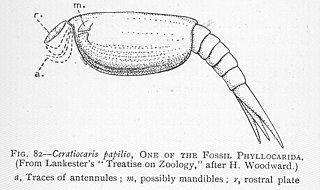 W
WCeratiocaris is a genus of paleozoic phyllocarid crustaceans whose fossils are found in marine strata from the Upper Ordovician until the genus' extinction during the Silurian. They are typified by eight short thoracic segments, seven longer abdominal somites and an elongated pretelson somite. Their carapace is slightly oval shaped; they have many ridges parallel to the ventral margin and possess a horn at the anterior end. They are well known from the Silurian Eramosa formation of Ontario, Canada.
 W
WDiastylis is a genus of crustaceans which belong to the family Diastylidae. It includes the following species:
 W
WDiastylis laevis is a species of crustacean belonging to the order Cumacea and the genus Diastylis. It occurs from Skagerrak to the Côte d'Ivoire, but not in the Mediterranean Sea. It grows up to 11 millimetres (0.43 in) long.
 W
WDouglasocaris is a genus of Notostraca fossil from the Middle Ordovician Douglas Lake Member of the Lenoir Limestone from Douglas Dam Tennessee.
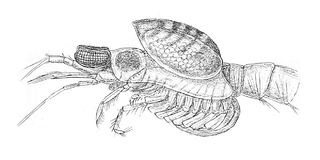 W
WErythrops is a genus of crustaceans in the family Mysidae.
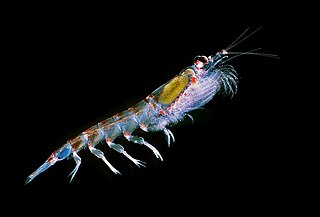 W
WEuphausia is the largest genus of krill, and is placed in the family Euphausiidae. There are 31 species known in this genus, including Antarctic krill and ice krill from the Southern Ocean, and North Pacific krill in the Pacific Ocean.
 W
WGammarus locusta is a species in the family Gammaridae ("scuds"), in the order Amphipoda ("amphipods").
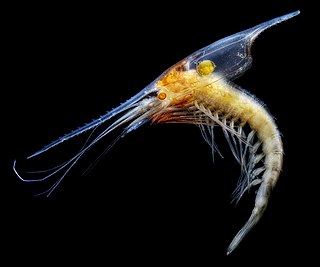 W
WGnathophausia is a genus of lophogastrid crustacean. There are 10 species recognized in the genus Gnathophausia:Gnathophausia affinis G. O. Sars, 1883 Gnathophausia childressi Casanova, 1996 Gnathophausia elegans G. O. Sars, 1883 Gnathophausia fagei Casanova, 1996 Gnathophausia gigas Willemoes-Suhm, 1875 Gnathophausia gracilis Willemoes-Suhm, 1875 Gnathophausia ingens (Dohrn, 1870) Gnathophausia longispina G. O. Sars, 1883 Gnathophausia scapularis Ortmann, 1906 Gnathophausia zoea Willemoes-Suhm, 1875
 W
WGnathophausia zoea is a species of lophogastrid crustacean. It is widely distributed in the Atlantic Ocean from the Arctic Circle to the Equator; in the Pacific Ocean, it is more restricted to tropical areas. The adults may reach 40–50 millimetres (1.6–2.0 in) long, excluding the rostrum, or around 70 mm (2.8 in) including the rostrum.
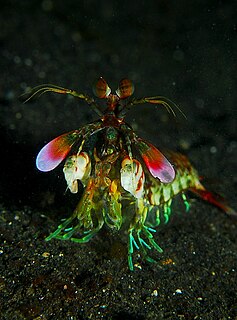 W
WGonodactylidae is a family of mantis shrimp. It contains the following genera:Gonodactylaceus Manning, 1995 Gonodactylellus Manning, 1995 Gonodactyloideus Manning, 1984 Gonodactylolus Manning, 1970 Gonodactylopsis Manning, 1969 Gonodactylus Berthold, 1827 Hoplosquilla Holthuis, 1964 Hoplosquilloides Manning, 1978c Neogonodactylus Manning, 1995
 W
WGonodactylus is a genus of mantis shrimp, containing the following species:Gonodactylus acutirostris de Man, 1898 Gonodactylus botti Manning, 1975 Gonodactylus childi Manning, 1971 Gonodactylus chiragra (Fabricius, 1781) Gonodactylus platysoma Wood-Mason, 1895 Gonodactylus smithii Pocock, 1893
 W
WGonodactylus smithii, the purple spot mantis shrimp, is a species of mantis shrimp of the smasher type. It is found from New Caledonia to the western part of the Indian Ocean, including Australia's north coast and the Great Barrier Reef.
 W
WHoplocarida is a subclass of crustaceans. The only extant members are the mantis shrimp (Stomatopoda), but two other orders existed in the Palaeozoic: Aeschronectida and Palaeostomatopoda.
 W
WHymenocaris is a genus of Cambrian crustaceans.
 W
WIphinoe is a genus of crustaceans which belong to the family Bodotriidae. It includes the following species:
 W
WKallidecthes is an extinct genus of crustaceans.
 W
WKiangsuaspis nankingensis is an extinct phyllocarid crustaceans from Late Silurian China. It was originally described in 1962 by Kiang P'an as an incomplete ventral plate of a cyathaspidid heterostracan agnathan with a unique pattern of raised, sculptured tubercles that fuse together into anastomosing ridges. In 1984, Jiang P'an then reappraised it as a ceratiocaridid crustacean.
 W
WLeptocheliidae is a family of malacostracans in the order Tanaidacea. There are more than 30 genera and 140 described species in Leptocheliidae.
 W
WLysiosquilla is a genus of mantis shrimp of the family Lysiosquillidae, containing these species:
 W
WThe Lysiosquillidae are a family of mantis shrimp, containing these genera:Lysiosquilla Dana, 1852 Lysiosquillina Manning, 1995 Lysiosquilloides Manning, 1977
 W
WNannosquillidae is a family of stomatopods, comprising the following genera:
 W
WNebalia is a large genus of small crustaceans containing more than half of the species in the order Leptostraca, with over thirty species:
 W
WNebalia herbstii is a leptostracan found in the north east Atlantic, including Galway Bay, Ireland. It is found in the intertidal zone in sandy and rocky shores. Total lengths are usually in the range of 2–6 mm (0.08–0.24 in). N. herbstii can be distinguished from other Nebalia species by a combination of characters:The denticles of pleon 6 and 7 are fairly short, rounded to obtusely pointed but never drawn out to acute constricted points. The length of the telson is longer than the length of pleon 7. A major feature are the anal scales located beneath the telson and furca. They have a short point over the centre of the scale with an indistinct “shoulder” which slopes steeply. The thoracopods have endopods which are long and slender, they are distinctly longer than the exopod. The dorsal terminal spine of the peduncle is comparatively short, reaching ½ to ⅔ the length of the dorsal spine row of the exopod. On the fourth pleopods the posterolateral corner of the peduncle is nearly rectangular, only very slightly pronounced to form an acute point. The sixth pleopods are slightly more than twice as long as wide.
 W
WNebaliidae is the largest of the three families of leptostracan crustaceans, containing 33 of the 40 described species. Its members may be dinstinguished from members of the other two families by the tapering form of the caudal furcae, and by the callynophores of the antennae in mature males, which are swollen in Paranebaliidae but not in Nebaliidae.
 W
WNematoscelis is a genus of krill, containing the following species:Nematoscelis atlantica Hansen, 1910 Nematoscelis difficilis Hansen, 1911 Nematoscelis gracilis Hansen, 1910 Nematoscelis lobata Hansen, 1916 Nematoscelis megalops G. O. Sars, 1883 Nematoscelis microps G. O. Sars, 1883 Nematoscelis tenella G. O. Sars, 1883
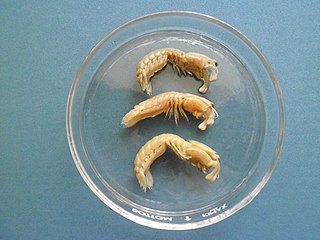 W
WNeogonodactylus is a genus of mantis shrimp. It contains the following species:
 W
WNeomysis is a genus of opossum shrimp from the family Mysidae, distributed in the coastal zone of temperate seas of the Northern Hemisphere and South America. Several species, particularly from the West Pacific, are also found in fresh and brackish waters. The genus contains the following 18 species:
 W
WNorthern krill, Meganyctiphanes norvegica, is a species of krill that lives in the North Atlantic Ocean. It is an important component of the zooplankton, providing food for whales, fish and birds. M. norvegica is the only species recognised in the genus Meganyctiphanes, although it has been known by several synonyms:Euphausia intermedia Euphausia lanei Holt & Tattersall, 1905 Meganyctiphanes calmani Nyctiphanes norvegicus G. O. Sars, 1883 Thysanopoda norvegica
 W
WOdaraia is a genus of crustacean arthropod from the Middle Cambrian. Its fossils, which reach 15 centimetres (5.9 in) in length, have been found in the Burgess Shale in British Columbia, Canada. 217 specimens of Odaraia alata are known from the Greater Phyllopod Bed, where they comprise 0.41% of the community.
 W
WOdontodactylus is a genus of mantis shrimp, the only genus in the family Odontodactylidae. Mantis shrimp of the genus Odontodactylus can not only detect circular polarisation of light, but can also detect polarised light reflecting off their telson and uropods.
 W
WOratosquilla oratoria is a species of mantis shrimp found in the Western Pacific. It is widely harvested in Japan where it is known as shako and eaten as sushi. Like other members of its order it has a powerful spear, which it uses to hunt invertebrates and small fish. It grows to a length of 185 millimetres (7.3 in), and lives at depths of 10–100 metres (33–328 ft).
 W
WParamysis baeri is a species of mysid crustacean from the genus Paramysis, named in honour of the prominent biologist Karl Ernst von Baer. Its body is 13–31 millimetres (0.51–1.22 in) long, and it is only found in the coastal waters of the Caspian Sea, on sandy and muddy bottoms, at depths of less than 20 m (66 ft). For over a century, it was thought to be distributed throughout the whole Ponto-Caspian basin, but recently the range was reconsidered after the rediscovery and re-establishment of the closely related species Paramysis bakuensis. Since the taxonomical status of P. baeri has been reconsidered, the distribution and ecology of the species remains poorly known. Paramysis baeri can be distinguished from P. bakuensis and other species of the subgenus Paramysis s. str. by the rather broad, almost quadrangular exopod of maxilla 2, the strongly serrated paradactylar claw-setae of pereiopod 6, and other features.
 W
WParasquillidae is a family of mantis shrimp containing the three genera Faughnia, Parasquilla and Pseudosquillopsis. It was previously included in the superfamily Gonodactyloidea, but that group was found to be paraphyletic, and a new superfamily, Parasquilloidea was erected.
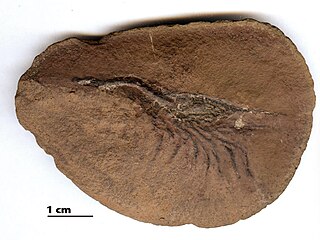 W
WPeachocaris is a genus of extinct crustaceans in the order Lophogastrida containing at least two species. Peachocaris were small shrimp-like crustacean that lived in the shallow seas of the late Carboniferous (Pennsylvanian). The species Peachocaris strongi is found in the Mazon Creek fossil beds, a carboniferous lagerstätte in Illinois.
 W
WPectocaris spatiosa is a Cambrian arthropod from the Maotianshan Shale similar in form to the Burgess Shale crustaceomorph Odaraia.
 W
WPhyllocarida is a subclass of crustaceans, comprising the extant order Leptostraca and the extinct orders Hymenostraca and Archaeostraca.
 W
WPraunus is a genus of mysid shrimp, comprising three species:Praunus flexuosus (Müller, 1776) Praunus inermis (Rathke, 1843) Praunus neglectus (G. O. Sars, 1869)
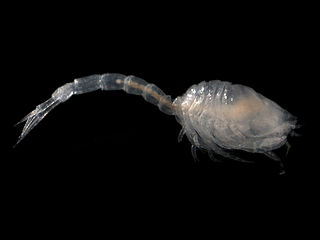 W
WPseudocuma is a genus of cumaceans, including the following species:Pseudocuma cercarioides Sars, 1894 Pseudocuma chevreuxi Fage, 1928 Pseudocuma ciliatum Sars, 1879 Pseudocuma diastyloides Sars, 1897 Pseudocuma gracile Sars, 1894 Pseudocuma graciloides Sars, 1894 Pseudocuma laeve Sars, 1914 Pseudocuma lagunae Baker, 1912 Pseudocuma longicorne (Bate, 1858) Pseudocuma simile G. O. Sars, 1900 Pseudocuma tenuicauda Sars, 1894
 W
WPseudocuma longicorne is a marine species of cumacean in the family Pseudocumatidae.
 W
WPseudocumatidae is a family of crustaceans of the order Cumacea. Its members have a small, free telson. The uropods bear endopods on one segment. The males have two pairs of rather rudimentary pleopods and the flagella of the second antenna reach far beyond the pereon. In females the second antenna is much smaller than the first antenna.
 W
WThe Pseudosquillidae are a family of mantis shrimp containing four genera and 11 species.
 W
WSquilla is a genus of mantis shrimp. It includes the following species:
 W
WSquillidae is a family of mantis shrimp, the only family in the superfamily Squilloidea. The type genus is Squilla. It is the stomatopod family with the most genera, as follows:
 W
WSyncarida is a superorder of crustaceans, comprising the two extant orders Anaspidacea and Bathynellacea, and the extinct order Palaeocaridacea. Fifty-nine living genera are known, in six families:Anaspidacea Calman, 1904Anaspididae Thomson, 1893 Koonungidae Sayce, 1908 Psammaspididae Schminke, 1974 Stygocarididae Noodt, 1963Bathynellacea Chappuis, 1915Bathynellidae Grobben, 1904 Parabathynellidae Noodt, 1965
 W
WThysanoessa is a genus of krill, containing the following species:Thysanoessa gregaria G. O. Sars, 1885 Thysanoessa inermis (Krøyer, 1846) Thysanoessa inspinata Nemoto, 1963 Thysanoessa longicaudata (Krøyer, 1846) Thysanoessa longipes Brandt, 1851 Thysanoessa macrura G. O. Sars, 1885 Thysanoessa parva Hansen, 1905 Thysanoessa raschii (M. Sars, 1864) Thysanoessa spinifera Holmes, 1900 Thysanoessa vicina Hansen, 1911
 W
WThysanoessa raschii, sometimes known as Arctic krill, is one of the most common euphausiid species of the subarctic and Arctic seas. They may reach 20–25 millimetres (0.8–1.0 in) long, and are sexually mature above 14 mm (0.6 in).